WEDNESDAY
MARCH 15 - 2017
Butterflies
On such a fine
spring day it was not surprising that some butterflies
would be about. I had a male Brimstone flying
through the garden this morning - my first of the
year. It did not stop for a photo.
However, a splendid Peacock did rest on a fence
post on the Railway Wayside this afternoon for a quick
snap. Interesting, there is what appears to be a
7-spot Ladybird on the bush to the left of the
butterfly in the photo. I did not notice it at the
time.
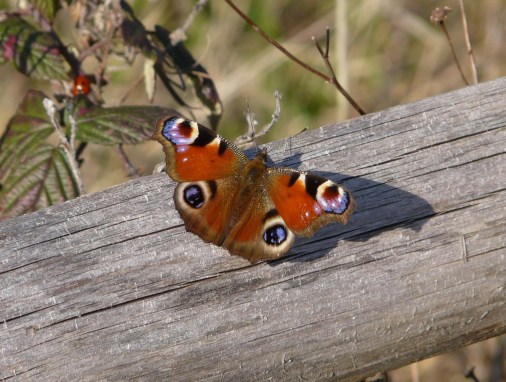
Langstone
swans
Christopher
Evans was down at Langstone Mill Pond and noticed the
female Mute Swan appeared to be nest building in the
reedbeds. The photo was taken shortly after
Christopher had crossed the little bridge, having
walked round the corner from the pub.
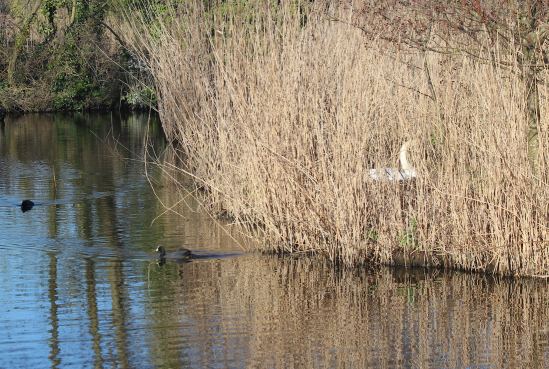
Newts
in pond
This afternoon
Peter Milinets-Raby checked around the garden and was
very surprised to find in the middle-sized pond a
crèche of tiny baby newts. He did not know they
bred like this. There were two patchiest of young in a
floating nest of about 30 centimetres across. Are they
colonial breeders? Peter assumes they are Palmate
Newts as that is all he ever sees in his Havant garden
Pond. Can anyone help please?
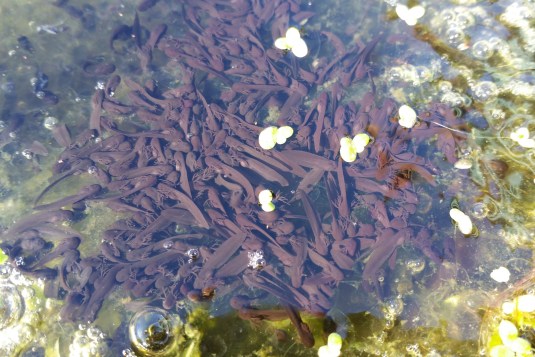
TUESDAY
MARCH 14 - 2017
I had a walk from home
to through the streets to Nore Barn and back to
Emsworth village via Western Parade. After a welcome
coffee in the Pastoral Centre I went down to the
Hermitage Millponds and back home through Brook
Meadow. Here are a few bird and flower observations I
made on the way.
Spotted
Redshank
The tide was
right in by the time I arrived at Nore Barn at 11.30.
The ever reliable Spotted Redshank was still present
feeding on the edge of the stream, close to the path.
After 13 years this bird never ceases to fascinate and
amaze me. The photo shows the bird with a small
crab.
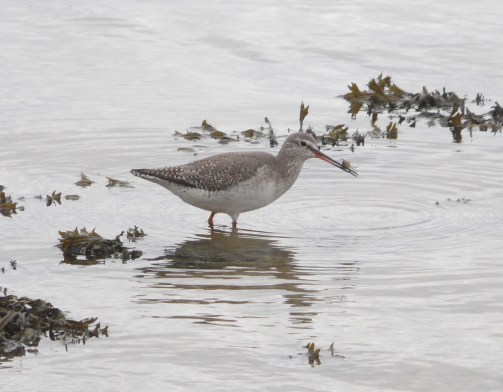
Brent
Geese
Brent Geese
numbers were considerably down on yesterday with only
about 50 present at Nore Barn and far less in the
eastern harbour. There was nothing else around apart
from a few gulls.
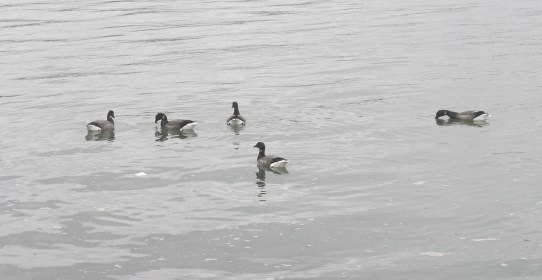
Black
Swans gone home
The six Black
Swans which have been resident in Emsworth Harbour
since Jan 27 have not been seen since Mar 11. Well, I
have just heard that they have gone back home to
Riverside Park, Southampton where they were born. M G
Painter reported the arrival of 6 Black Swans at
Riverside Park on Mar 13 on the HOS GoingBirding web
site. Mr Painter notes that the cob of nesting pair
was not happy to see them all arrive. Here is a photo
of them in Emsworth as a reminder. So, goodbye, it was
nice having you.
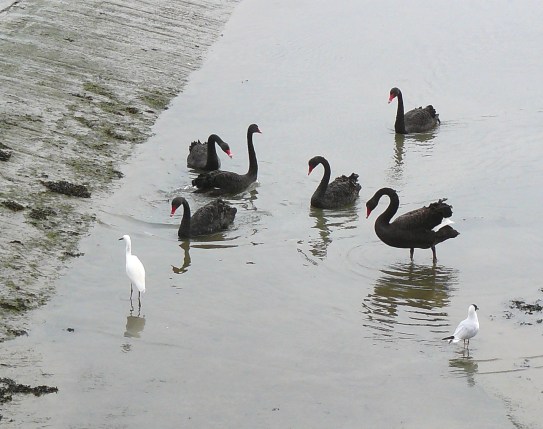
Millpond
swans
One of the
Mute Swans resident on the town millpond was in the
harbour near the quay when I passed by this morning,
busily driving off another swan from its territory.
Its mate was still on the pond. I watched the swan
drive its adversary right out into the harbour. There
is no sign of any nest building on the millpond by the
pair.
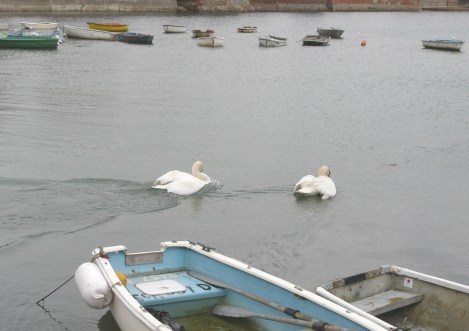
Peter
Pond swans
Over on Peter
Pond I found the Mute Swan pair on the island near the
main road with one of the pair indulging in some
preliminary nest building activity. However, the site
being worked on is far too low and would be readily
inundated by the water level at high tide. Any nest
site would have to be on a higher part of the island.
The swans have not actually nested on the Peter Pond
island for a few years, preferring the relative safety
and privacy of the reedbeds on the east side of
Slipper Millpond.
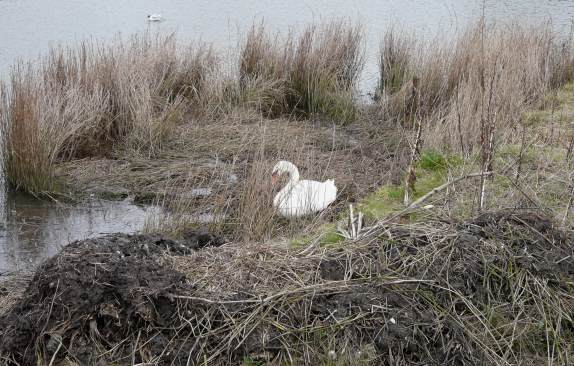
Great
Black-backed Gulls
The pair of
Great Black-backed Gulls were both ensconced on the
centre raft on Slipper Millpond. As far as I could
see, there has been no nesting activity as yet, but
with both birds present this cannot be too long away.
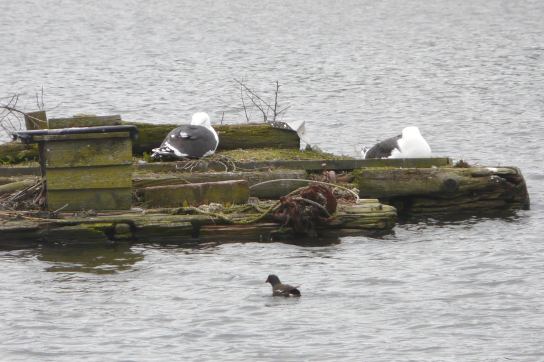
Plants
Now for the
plants . . . .
A very nice Petty
Spurge caught my eye as I walked along Convent
Lane. Its stems of bright red stand out clearly from
the wall it grows against. The pale green flowers have
four crescent-shaped glands with long 'horns'. It
grows almost anywhere where there is disturbed soil,
including pavement cracks. Botanically it is
classified as an archaeophyte, ie an ancient
introduction.
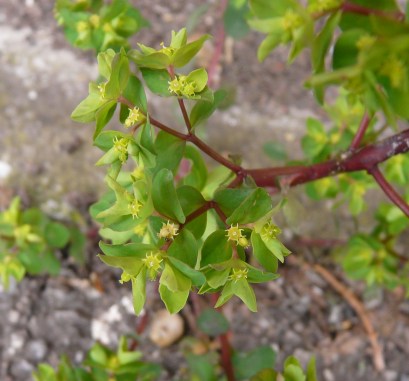
Very similar is
Dwarf Spurge, though this is an arable weed and
much rarer. One can usually find it growing on the
field behind Conigar Point in late summer. Here is a
photo I took of it on that field a few years ago.
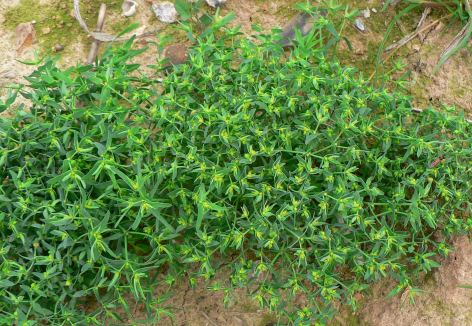
I stopped to admire a fine Laburnum tree in
full blossom in a front garden on Clovelly Road.
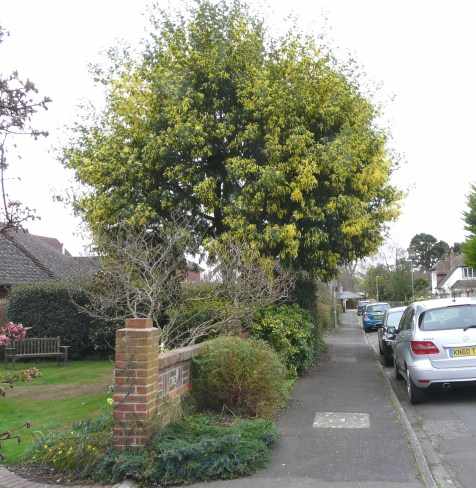
Walking along Warblington Road I found Greater
Periwinkle in flower on the edge of the pavement.
Apart from its larger size, it can be distinguished
from Lesser Periwinkle by the line of hairs along the
edges of its leaves.
Also on Warblington Road I spotted my first Garlic
Mustard flowers of the year. Walking back from
Nore Barn along Western Parade I noted my first
Green Alkanet of the year.
Summer Snowflake (Leucojum
aestivum) was also in flower with its hanging
white bells with green spots at the tips of the
petals. Summer Snowflake (which is misnamed as it
flowers in spring) can be distinguished from
Three-cornered Garlic flowering nearby, the
petals of which have thin green lines running down
them.
MONDAY
MARCH 13 - 2017
Nore
Barn
I went over to
Nore Barn at 09.30 to catch the rising tide. It was a
lovely spring morning, sunny calm and quite warm, but
the bright sun off the sea made photography difficult.
I was using my Lumix FZ18 with a new wrist strap which
is easier than having the camera in my bag or dangling
around my neck.
I met my friend 'Hutch' (real name Ian) who lives in
Seagull Lane. Hutch loves his wildfowl and was busy
checking them out on the mudflats. Wigeon and Teal are
still present in small numbers and he also spotted two
pairs of Pintail way out in the channel.
I walked along the shore to wait for the tide and
discovered my Peacock butterfly of the year,
basking in the warm sunshine on the shingle beach.
There have been several other Peacock sightings today,
so it looks like a major emergence.
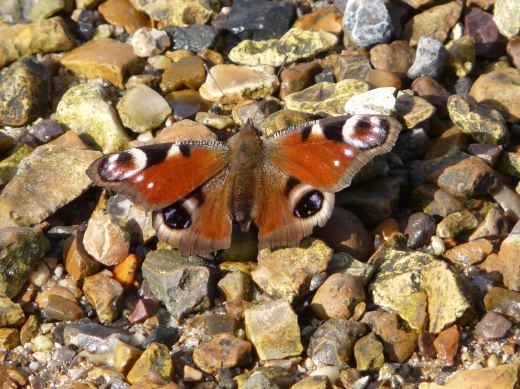
About 300 Brent Geese
were lingering in the creek south of the woods along
with a few Teal
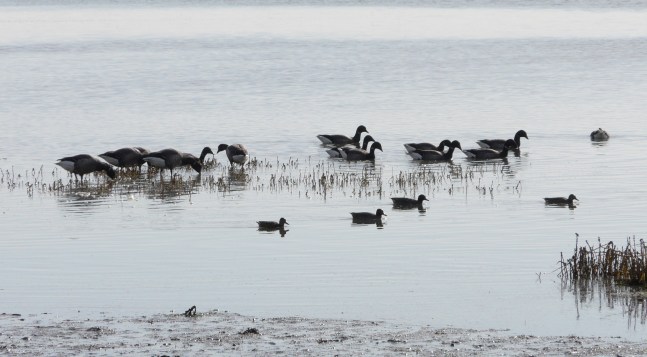
I found the Spotted
Redshank feeding on the shore near saltmarshes
with a regular Redshank. It will probably be with us
for another week or so before migrating to Northern
Scandinavia.
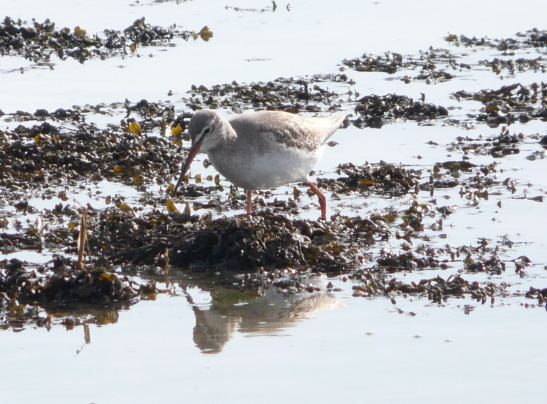
Black
Swans gone?
This afternoon
had a quick look at the harbour to check on the six
Black Swans, but they were not in their accustomed
place near the quay. Nor were they anywhere else to be
seen in the immediate harbour. Have they moved on?
Five Black Swans were first seen in Emsworth Harbour
on Jan 27th and on Feb 19th a 6th bird arrived. Since
then all six have been regular in the harbour. They
probably originated from Riverside Park (Cobden
Meadows) on the River Itchen estuary in Southampton.
Spring
flowers
I was pleased
to see a good crop of flowering Common
Whitlowgrass on the cobbled area close to the
ornamental flowerbed boat where West Street meets the
main road in the centre of Emsworth. This is a regular
spot for this pretty white flower (not a grass!).
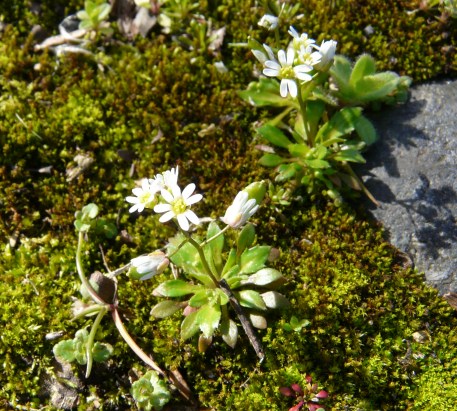
I also noted the first
flowers of Cow Parsley on the wayside verge in Bridge
Road car park. In a few weeks the waysides will be
lined with this wonderful aromatic plant.
Slipper
Millpond
This afternoon
on Slipper Millpond, two Cormorants were on the south
raft, a single Great Black-backed Gull was on the
centre raft, the Mute Swan pair were present, but no
sign of their nesting in the reedbeds. Three pairs of
Coot are resident on the pond and will nest somewhere.
When he was passing this morning, Chris Oakley noted
that the nest box on the south raft was full of nest
material. There is no movement on the north raft.
I happened to meet Brendan Gibb-Gray returning from
litter picking on Brook Meadow. He does a valuable job
and the conservation group are very appreciative of
his efforts. Well done, Brendan.

Pied
Wagtail in garden
It was good to
see a Pied Wagtail on the grass in our back garden. I
have had several sightings of a Pied Wagtail over the
20 years we have lived in our Bridge Road house, but
this was the first I have seen since March 2013. The
bird did not stay for a photo, but here is a nice one
I managed to get in February 2009.
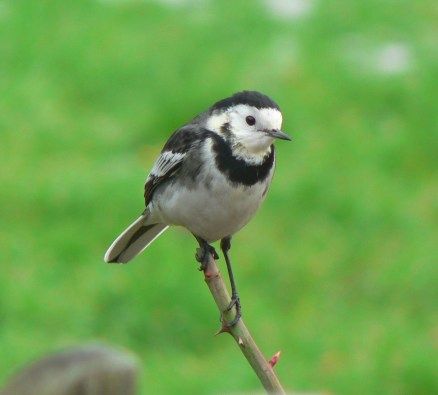
Carrion
Crows
Coming back
through Brook Meadow my only observation was of four
Carrion Crows feeding on the north meadow. These
handsome birds are regular foragers on the meadow and
probably nest in the local woodland.
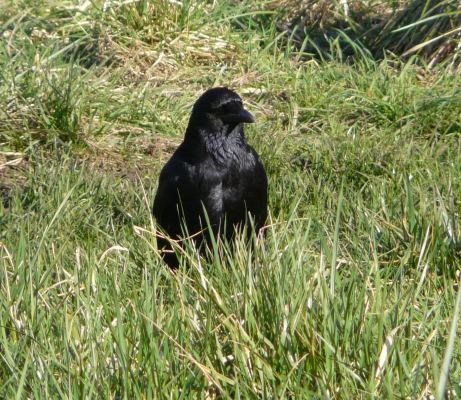
Thorney
Little Deeps
Chris Oakley
took a walk out to Thorney Little Deep this morning.
The thorn bushes are now in full of blossom and Lesser
Celandine and violets are showing well. Chris found a
small clump Common Bonnet fungi beside the top
path.
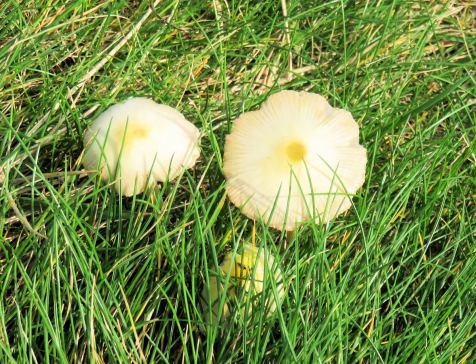
Chris noted there was
a solitary Brent Goose out on the grass below the
deep. This is probably an old or ailing bird that will
not be moving off with the rest of the geese to their
breeding grounds in the High Arctic.
Langstone
Mill Pond
Peter
Milinets-Raby visited Langstone Mill Pond this morning
from 9:35am to 10:55am - tide pushing in. The birds of
note were as follows:
Off shore: 174 Brent Geese, 146 Black-tailed Godwit, 5
Shelduck, Pond Pintail female, 91 Teal, 1 Sandwich
Tern - tatty looking and probably an over wintering
bird, 2 Med Gulls, 13 Red Breasted Merganser, 3
Buzzard, 3 Greenshank, 3 Wigeon.
Langstone Mill Pond: 14 Little Egrets roosting,
through 2 of them were at the edge of the Holm oak
looking interested? Seven Heron nests occupied. Two
small chicks seen in the top Holm Oak nest. 2
Chiffchaff singing - first true migrants
Horse paddock: 3 Little Egrets, 2 Grey Heron, 31 Teal,
32 Wigeon, 4 Moorhen, 1 Green Sandpiper, 3 Redwing, 2
Foxes.
Long-tailed
Duck
Having only
seen a Long Tailed Duck for the first time 10 days ago
at Ivy Lake, Christopher Evans has had two further
sightings in the last 3 days, both in the northeast
corner of Langstone Harbour just across the road from
The Ship.
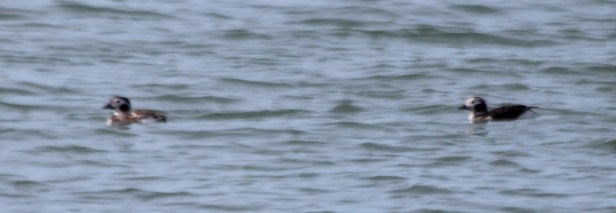
Also there this
morning were circa 50 Red Breasted Mergansers. It was
a lovely morning to be out with lots of birdsong and
glimpses of Blue, Great and Long Tailed Tits,
Goldfinch and the ubiquitous Robin. On the his way
back up the Hayling Billy line, Chris also saw a
Peacock butterfly.
FRIDAY
MARCH 10 - 2017
Spotted
Redshank
I went over to
Nore Barn at 12 noon mainly to check on the Spotted
Redshank. The tide was still well in and the stream
fairly full of water. There was a heavy mist, almost
fog, over the water. I was delighted to find the ever
reliable Spotted Redshank feeding among the seaweed on
the edge of the stream. I had not seen it for a while
so took a few photos in a very grey light.
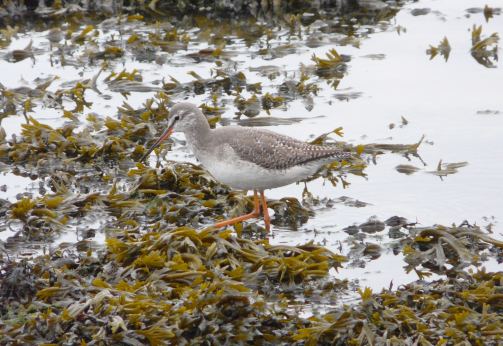
The bird is still
looking just as good as it did 13 years ago! Amazing.
This is still early days for the bird's departure for
its breeding ground in Northern Scandinavia. On the
basis of previous last dates, I reckon it will be here
for another week or so.
There is a special web page for the Emsworth Spotted
Redshank, its history and photos . . .
Spotted
Redshank
Brent
Geese
The only other
birds of interest at Nore Barn, apart from a few Teal,
were the Brent Geese of which I counted 82 when I
first arrived. However, as I was walking back along
the shore about 30 minutes later, a large flock of
over 200 flew into the Nore Barn stream area, honking
joyously as they arrived. These charming birds will
probably be around for a couple of weeks yet, before
they too depart towards their breeding grounds in the
High Arctic.
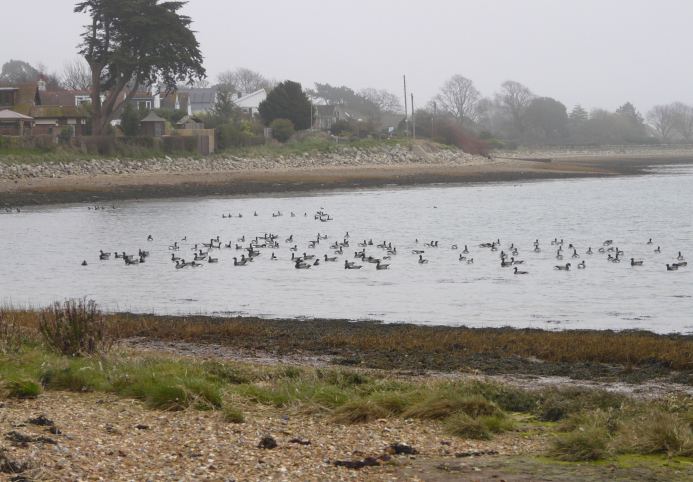
Spring
blossom
Along the
shore to the south of Nore Barn Woods I spotted the
first of the Blackthorn blossom just opening
up.
On the way home I noticed that the Goat Willow male
catkins are opening on the tree on the Bridge Road
car park wayside.
Garden
Blackcap
The female
Blackcap is still a daily visitor to our back garden
where it prefers the sunflower heart feeders to the
apples and other tit bits. She has been a regular
garden visitor since early February, but always alone.
I have not seen a male all winter. She will soon be
moving back to her breeding grounds, probably
somewhere in Central Europe. For more details on their
migration see . . . http://btoringing.blogspot.co.uk/2017/02/where-do-our-wintering-blackcaps-come.html?dm_i=IG4,4R94I,3RN36S,HX73V,1
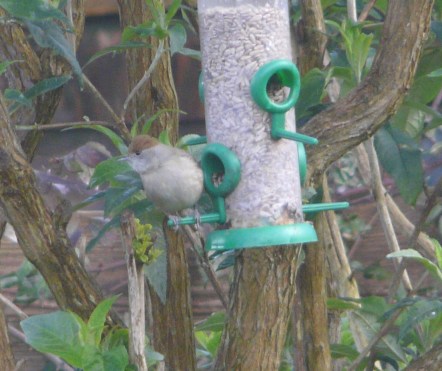
THURSDAY
MARCH 9 - 2017
Wayside
flowers
I had a late
afternoon walk around some of the local waysides on
the look out for early spring flowers. I found just a
few flowers of Coltsfoot struggling through the
brambles on the Railway Wayside north of Emsworth
Railway Station near the access ramp.
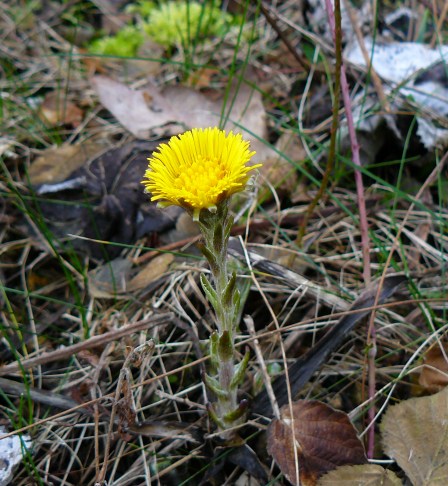
I spotted one flower
of what looks like Early Dog-violet, with its
two upper petals sticking up like rabbit's ears, near
a garden fence along New Brighton Road north of the
southern junction with Christopher Way.
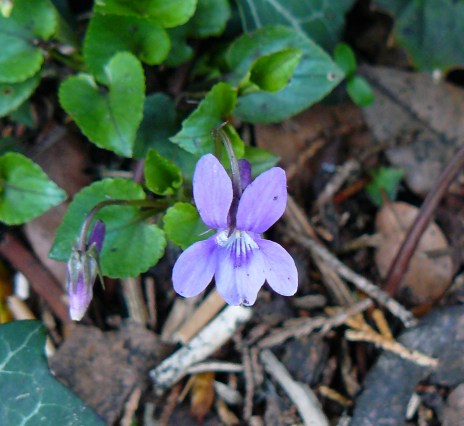
Leaves of Wild
Clary are now clearly showing in the usual places
on the grass verge at the northern end of Christopher
Way. Let's hope the Council cutters give them a miss
this year.
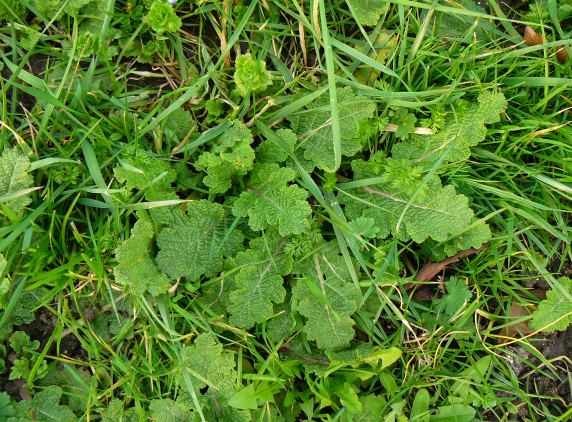
There is also a good
growth of Shining Cranesbill along the path
leading through to Bellevue Lane.
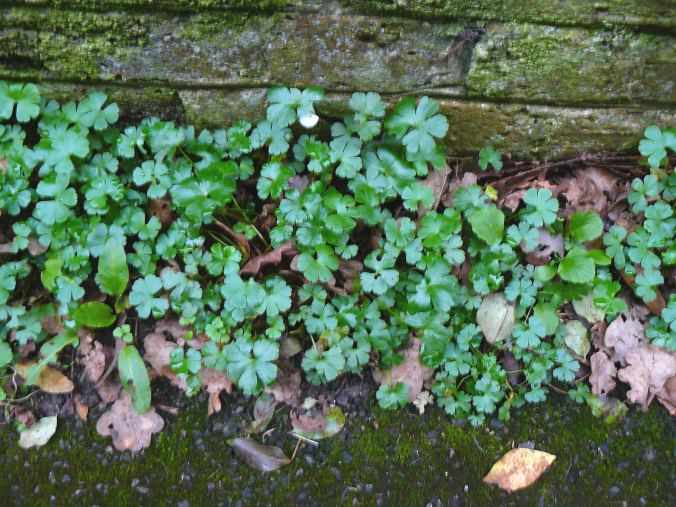
Emsworth
to Langstone
Peter
Milinets-Raby was out this morning for a high tide
walk around the whole area. The highlights were as
follows:
Beacon Square
(from 9:06am): 359 Brent Geese, 2 Teal, 1 Turnstone
roosting on a buoy, 5 Red Breasted Merganser, 1 summer
plumaged Sandwich Tern resting on a buoy - unlikely to
me a migrant, just one of the wintering birds, 3 Med
Gulls, 2 Shelduck, 63 Oystercatchers roosting on the
salt marsh (low high tide), 1 Goldcrest in the back
gardens.
Emsworth
Harbour: 174 Brent Geese, 3 Cormorants on Millpond
- one showing continental race features - see
photo.
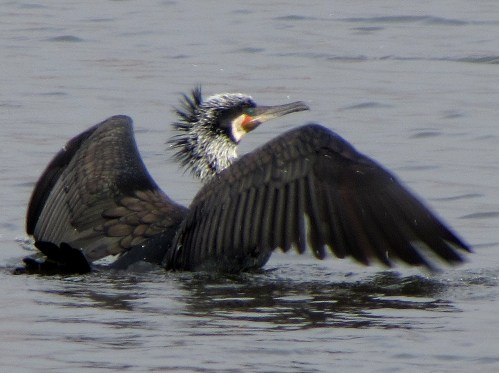
5 Little Grebe, 15 Med
Gulls on the pier with a further 4 out in the harbour,
25 Coot with an extra 11 on the millpond, 2 Lesser
Black-backed Gulls, 6 Black Swan, 10 Mute Swan, 1
roosting Greenshank by wall, 1 Red Breasted Merganser.
Nore Barn from
9:57am: 188 Brent Geese, 4 Teal, 25 Shelduck, 5 Red
Breasted Merganser, 1 Great Crested Grebe - first of
the winter.
Warblington
from 10:11am: Ibis Field: 4 Stock Dove, Green
Woodpecker Heard, 5 Moorhen, 1 Great Spotted
Woodpecker, 1 Grey wagtail, 1 Buzzard, 1 Skylark
singing over big fieled to the east.
Conigar Point:
8 Wigeon, 4 Brent Geese, 3 Red Breasted Merganser, 2
Little Grebe.
Off Pook Lane:
14 Wigeon, 87 Brent Geese, 7 Med Gull, Field south of
cemetery held 4 Teal and a Wigeon. 9 Shelduck, 9 Grey
Plover, 2 Stock Dove, 2 Buzzard, 1 Meadow Pipit, 1
Kestrel.
Wade Lane from
11:03am - finish at 11:53am; 2 Mistle Thrush, 13
Little Egret in roughed up/muddy pony field, 21 Pied
Wagtail - some stunning looking birds amongst them -
see photo, 1 Stock Dove, Green Woodpecker heard.
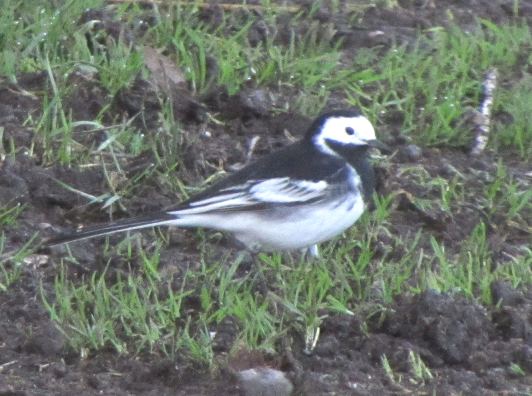
Flooded
paddock: 6 more Little Egrets, 2 Grey Heron, 156
Teal, 22 Wigeon, Pond Pintail female. off shore: 52
Black-tailed Godwit, 9 Med Gulls.
Langstone Mill
Pond: 2 Teal.
We have another Grey Heron nest being built bang
between the two Holm Oaks at great height - number 10.
The bird sticks out like a sore thumb at the moment,
suspended almost in mid air. Can the colony have any
more?
Also this morning the nest in the top of the Holm Oak
had young in it - I could hear calling and could see
the movement of a bill and a little shaggy head,
however, I sensed that the calls were emanating from
one of the other nests in the Holm Oak. The nest low
down at the front had no 'life', but the nest to the
rear had an adult sat on it, making a lot of fuss. So
possibly two nests with young?
Three other nests occupied, with two others possibly
occupied. So seven nests up and running out of the
ten.
Med
Gulls at Hayling Oysterbeds
Graham Petrie
had a quick walk round Hayling Oysterbeds this
afternoon and was amazed at the number of
Mediterranean Gulls on the islands. A young RSPB guy
down there estimated there were 420. Currently, they
appear to outnumber the black-headed gulls which is
amazing. Hopefully they will have a good year and we
don't get any late storms that coincide with high
tides! Wow! Look at Graham's picture. Looks like no
room left in the stable for the terns this year?
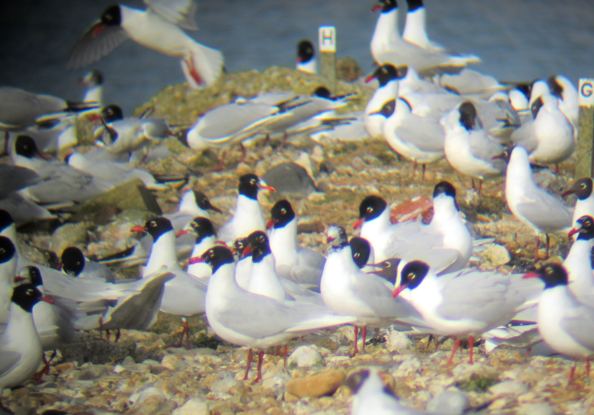
Brimstone
Wally Osborne
saw his first very sprightly Brimstone butterfly of
2017 this afternoon in his North Emsworth garden.
Hardly surprising, he says, with sunshine and
temperatures in the upper teens. Unfortunately, I have
not seen anything today despite a couple of walks.
Brian Lawrence had a Brimstone in Havant Thicket a few
days ago.
Brimstone adults emerge from hibernation, usually in
woodland, or in Holly and Ivy, on the first warm days
of spring and immediately set about looking for mates
and egg-laying sites in Alder Buckthorn bushes.
Here
is a male Brimstone that I got in early spring
in Hollybank Woods a couple of years ago
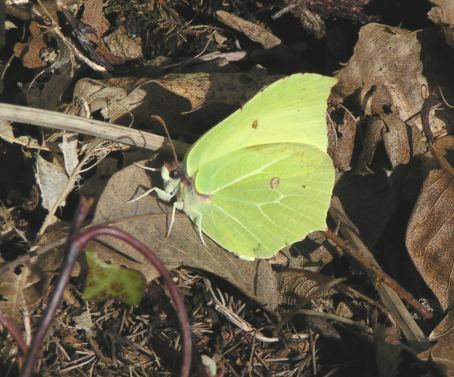
WEDNESDAY
MARCH 8 - 2017
Emsworth
Millpond
I decided to
venture out for a stroll around the local millpond
when the rain finally relented late morning. The
Swan nest is still swamped by high water near
the bridge. They will no doubt have another go at
building it up, though this will not be an easy job
unless the water level in the pond is controlled by
the Environment Agency as it was in previous years
when swans nested there.
Several Coot were chasing around the millpond,
making those loud clicking noises, in hot pursuit of
one another as the hormones start to flow.
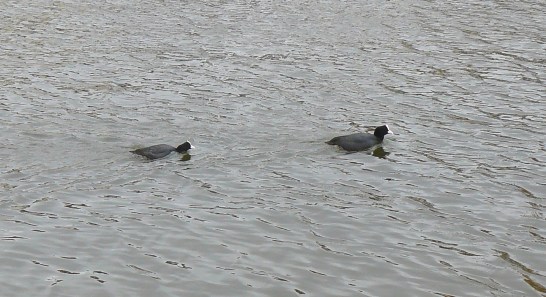
Brent Goose
numbers in the harbour appear roughly the same as
when I last looked a few days ago - about 300 in the
main channel. The six Black Swans were in their
favourite spot by the quay at the end of South Street.

Today, they had a very
handsome and plumed Little Egret as company.
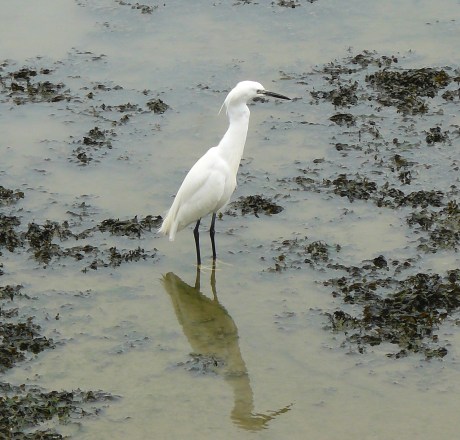
Ivy-leaved
Toadflax
While I was
walking along the east beach, towards the end I found
a good flowering of Ivy-leaved Toadflax on the
seawall. The main flowering period of Ivy-leaved
Toadflax is Apr-Dec though it readily flowers
throughout mild winters in Southern England and can be
found in many local spots.
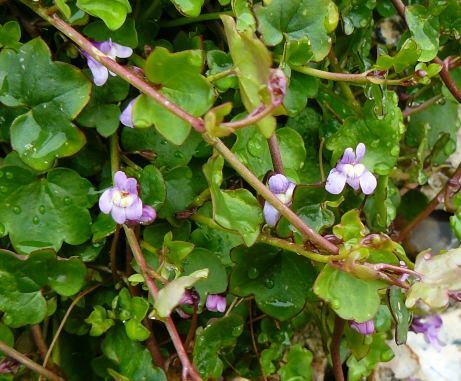
This attractive plant
was first introduced into gardens in Britain from the
Mediterranean Region in 1602 and was recorded in the
wild soon after. It easily escapes and establishes
itself on vertical walls where it gains hold in the
crevices and joints, but is equally at home in
quarries, rubbly open ground and shingle beaches. In
fact, it is Britain's 7th most frequent neophyte,
recorded in 65.69% hectads in the British Isles.
Pineappleweed is the top alien.
Ivy-leaved Toadflax has a rather clever means of
reproduction which enables it to spread easily over
walls. After fertilisation, the flower stalks, which
initially grow towards the light, reverse their
direction and point towards the darkness of the nooks
in the walls where the seeds can germinate. It also
spreads through stolons. The excellent book by Stace
and Crawley: Alien Plants (Harper Collins, 2015) was
my main reference for this information.
Mediterranean
Gulls
My walk along
Emsworth east beach was accompanied by the constant
yelping calls of Mediterranean Gulls as they flew
around overhead. These calls are very different from
the rather harsh screams made by Black-headed Gulls.
Hence, I was not at all surprised to find several Med
Gulls on the water of Slipper Millpond. I think there
are at least 5 Med Gulls in the following photo. Can
you sort them out from the Black-headed Gulls?
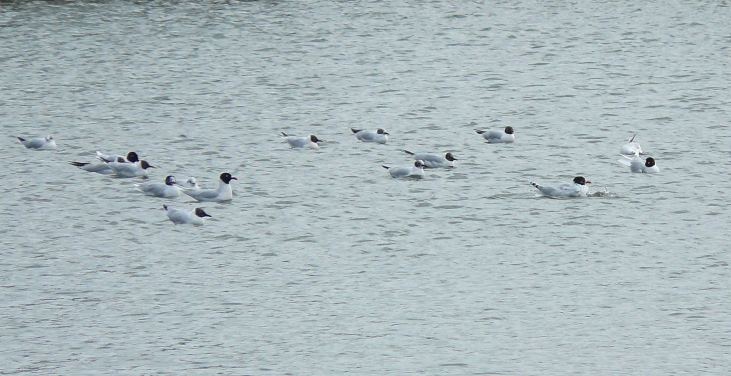
Look out first for
pure white wings of the Med Gulls; Black-headed Gulls
always have back tips to their wings. One exception to
the pure white wing rule can be seen in the third gull
from the right in the photo; this is a second year Med
Gull which has some black markings on the end of its
tail. Other distinguishing features of the Med Gull
include a jet back head, which is more brown in the
Black-headed Gull, a bright red and less pointed bill
than in the Black-headed Gull.
Ralph Hollins noted in his wildlife diary entry for
yesterday (Mar 7), Mediterranean Gulls are now back in
force on the islands at Hayling Oysterbeds, seeking
the best nesting spots among hundreds of Black-headed
Gulls. They also nest in colonies on the main RSPB
islands in Langstone Harbour. See . . .
http://ralph-hollins.net/Diary.htm
Mistle
Thrush song
With all the
excitement over the Ravens at Stansted yesterday, I
completely forgot to mention that a Mistle Thrush was
singing strongly in the east park behind Stansted
House. This was the first Mistle Thrush I have heard
this year, though I am sure they will have been
singing for some time. The bird's fine voice carries
quite a distance and is easy to identify, though needs
to be distiguished from the mellower tones of a
Blackbird. Here is one singing from a tree top that I
got a few years ago on Hayling.
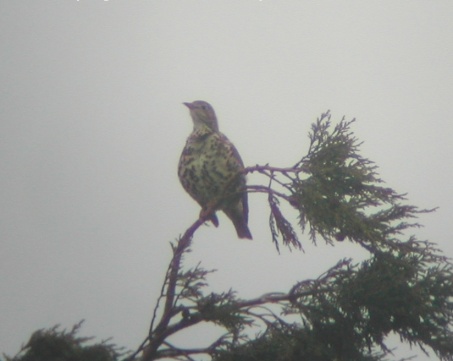
Square
Spider's Web?
We have a
square-shaped spider's web on the inside of one of the
high windows in the back room. I always think of orb
spider's webs as being round, but this one clearly is
not. It also does not seem to be a terribly well made
web, so maybe it is an early effort by a juvenile
spider? Or is it an abnormal web of a normal spider?
Or has it been made by a less common spider? A quick
search on Google did not reveal any definite answer.
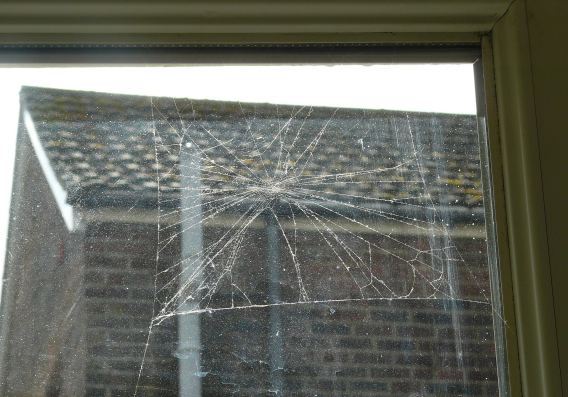
TUESDAY
MARCH 7 - 2017
Stansted
Forest East
It was such a
beautiful morning, that Jean and I could not resist a
walk through the wonderful Stansted Estate which is so
well maintained by Head Forester Michael Prior and his
team. Parking by the Garden Centre we walked the very
muddy track in front of the house, then up the main
eastern path as far as the 'five-ways' finger post and
back.
We stopped to admire the flowering Camellia by the
Iron Gate Cottages and the magnificent black Highland
cow in the field opposite the cottages with two light
coloured calves. One of the calves is hidden behind
its mother and only its front leg can be seen. Sorry
about the photos, the camera was misbehaving.
Walking along the
eastern track towards Walderton, we kept a close look
out for the Yellowhammers that the Havant Wildlife
Group heard and saw on their walk last Saturday
morning, but we had no sight or hearing of any, though
there were plenty of other birds scuttling around the
hedgerows, including Dunnock, Chaffinches and Meadow
Pipits. Here is a shot of the eastern track looking
east.
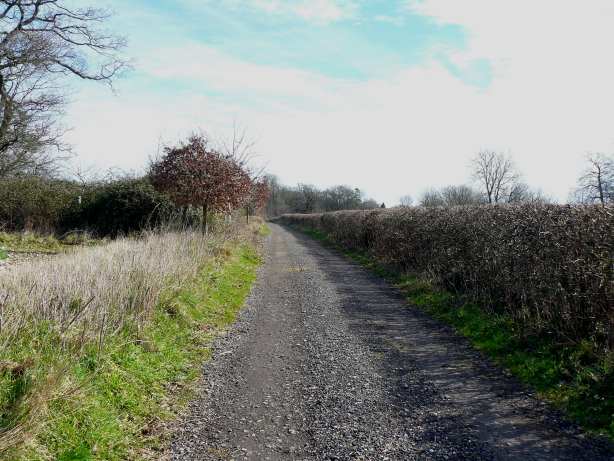
We noted that many of
the young Oaks by the side of the track had retained
their (now brown) leaves. The retention of leaves over
winter by broadleaved trees is called marcescence.
Botanists are unsure why some trees develop this habit
though it does not appear to do them any harm.
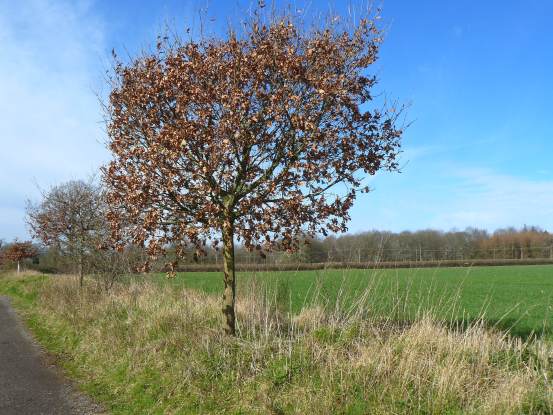
The hedgerow is mainly
Hawthorn not yet in leaf. However, one plant stood out
prominently being covered in bright green leaves.
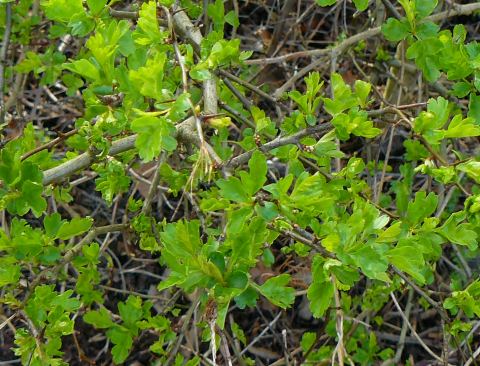
The main hedgerow has
been planted only on the south side of the track which
allows excellent views to the north across broad
fields to Lumley Lodge.
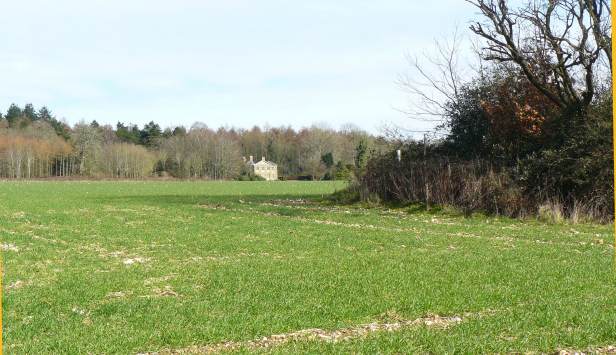
Dog's Mercury was in
full flower near the wooded area at the far end of the
eastern track.
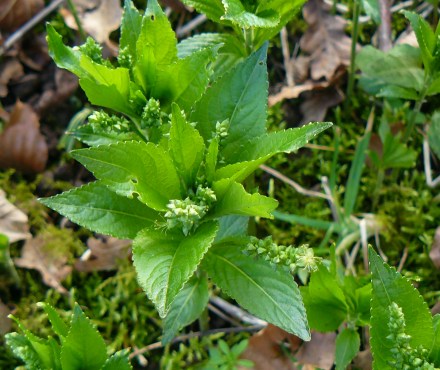
Our best sighting of
the morning was basically our last. As we came down
the slope from the Iron Gate Cottages, we heard the
croaking of Ravens. Looking up we saw two Ravens
flying overhead heading towards the fields below the
house. We had heard some croaking earlier in the walk
but could not locate it.
I gather that at least two pairs of Ravens nested on
the Stansted Estate last year. We always recall the
great view we had of two Ravens in February 2014 when
one of them perched on a post as we walked along the
path in front of Stansted House. A truly memorable
occasion, not repeated today unfortunately. But it is
always good to see Ravens.
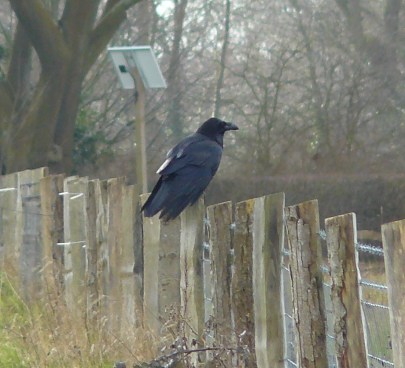
Thorney
Talk
Tim Kenealy,
Station Staff Officer at Baker Barracks, Thorney
Island will be talking about "Thorney Life" including
its military history, current activities/strategic
importance, role in preservation of wildlife and flood
prevention plans.
Date Friday 17th March at 7.00 for 7.30pm at the
Pastoral Centre in Emsworth Square.
This is a talk organised by the Slipper Millpond
Preservation Association.
Photographing
Owls
Richard Ford
has created a superb summary of his experiences in
photographing Owls in Hampshire. This is a fascinating
article illustrated with many beautiful photos with
lots of tips of how to take them. Well worth a
look.
See . . . http://www.digitalwildlife.co.uk/artical/OwlPhotography.htm
MONDAY
MARCH 6 - 2017
Emsworth
Millponds
I had a walk
around the three main Emsworth millponds this morning.
Emsworth Marina is the 4th millpond - or was until it
was converted into a marina. The Swan nest on the town
millpond was totally swamped and will need rebuilding.
The two swans were not in attendance.
I estimated 400 Brent Geese were in the main channel
of the harbour, so there are still plenty about. They
should be gradually moving off as the month
progresses, but more should be moving through.
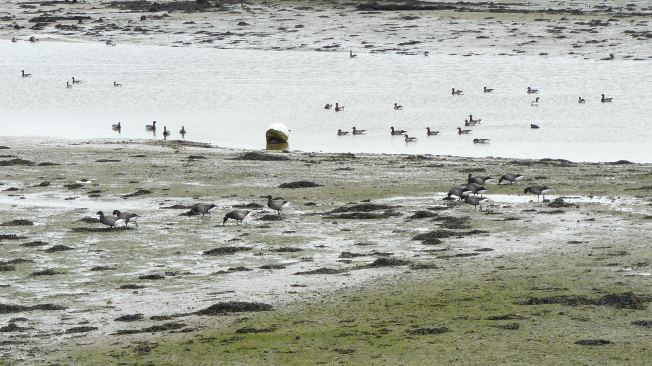
A Great Black-backed Gull was on its favourite perch
on the red topped post. It is probably one of the
nesting pair from Slipper Millpond.
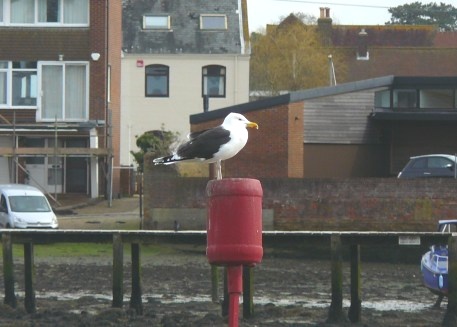
Godwit
on millpond
John Jury sent
me a photo of a Black-tailed Godwit that he saw on the
town millpond on Saturday. Godwits do occasionally
come onto the millpond when the water is low, but this
is a rare occurrence.
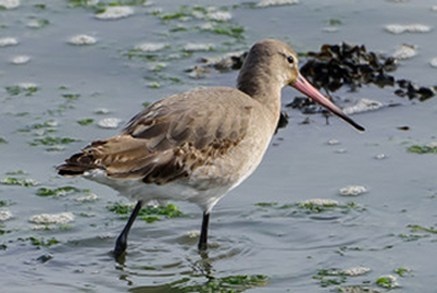
Slipper
Millpond
Over on
Slipper Millpond the much enlarged south raft has been
taken over by gulls, but not for nesting I guess. The
nest box that Coots have nested in in the past has
gone, but a pair are still hanging around the raft.
Maybe they will try again, but if they do they will be
terribly exposed to attack by the Great Black-backed
Gulls. Interestingly, a Moorhen was on the raft while
I was there. I am not sure where they nest on the
pond.
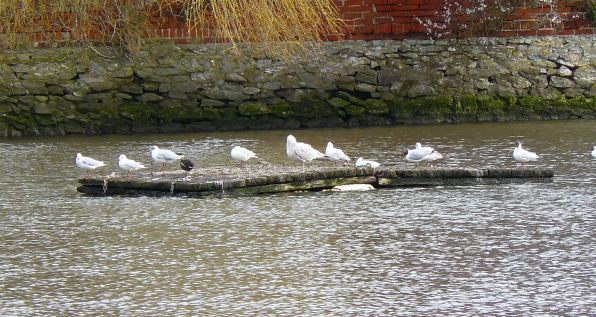
Peter
Pond Water Rail
I got a good
view of the resident Water Rail on the east bank of
Peter Pond, poking around in the remains of the duck
feed that David Gattrell throws out.
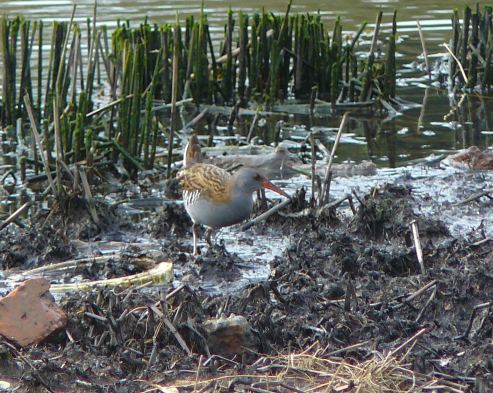
Brook
Meadow
I came back
home through the meadow where I had a good look for
our Water Rail, but there was no sign of it anywhere.
I met Brian Lawrence with his long lensed camera and
we had a chat about Water Voles and other things. He
had not seen much apart from common resident birds,
including this sweet Robin singing its heart out.
Brian also had a Brimstone butterfly in Havant Thicket
a few days ago, the first locally that I have heard
of. Here is the photo.
Salterns
Quay
Mike Wells had
a short stroll along the Eastern Road sea wall at
Langstone Harbour this morning, near where the
Salterns Quay pier was removed last year. He found a
good selection of waders including a 'ringed' Redshank
and a lone Dunlin. Pete Potts and his team ringed a
large number of Redshank a few years ago, but due to
the mud, one can't see enough of the Redshank's rings
to read them clearly.
SUNDAY
MARCH 5 - 2017
Brook
Meadow
I went over to
the meadow for the regular first Sunday in the month
work session. The sky was heavy with rain clouds which
burst from time to time during the morning with cold
showers. However, the group of volunteers were not at
all disheartened and kept at their various tasks
throughout the morning.
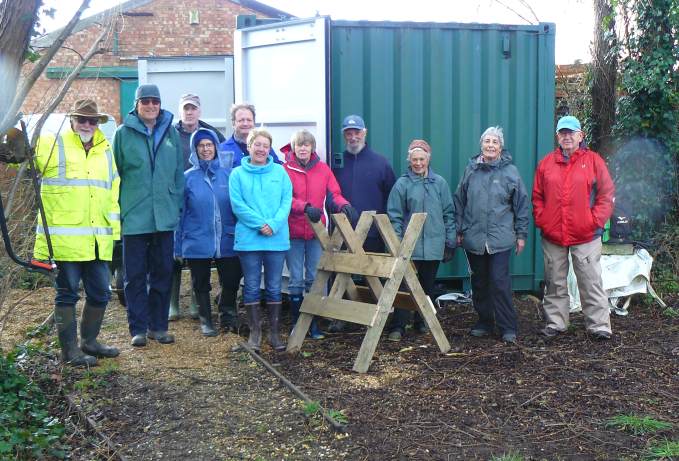
The main job was
cutting and clearing branches from the large Crack
Willow that had come down on the north meadow earlier
in the winter.
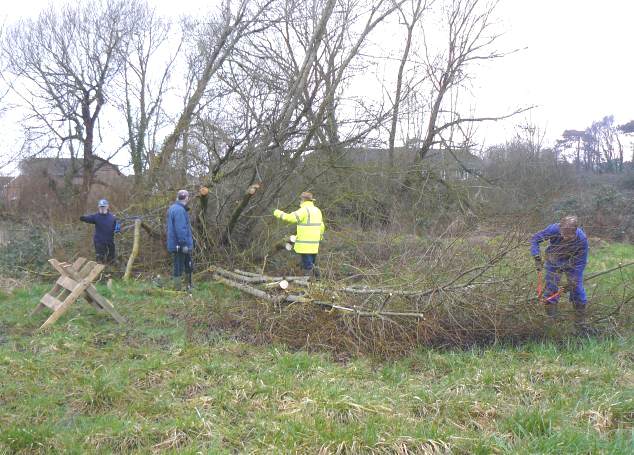
The logs were moved to
the Seagull Lane gate where people were invited to
help themselves for firewood.
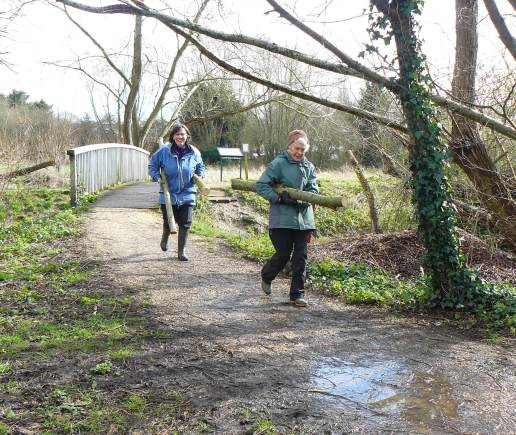
For a fuller report on
the work session and more photos go to . . .
http://www.brookmeadow.org.uk/conservation-news/
Wildlife
observations
The Butterbur
spikes are now springing up all over the area beneath
the seat and it could be another good year. I shall do
the annual count of flower spikes towards the end of
this month.
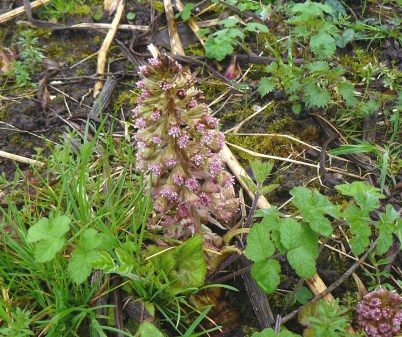
The Cherry Plum
tree is now in full blossom and looking very good near
the Lumley gate. The Weeping Willow is also a
fine spectacle at the north end of the south meadow.
The catkins are
opening on the female Goat Willow which grows
right beside the Weeping Willow.
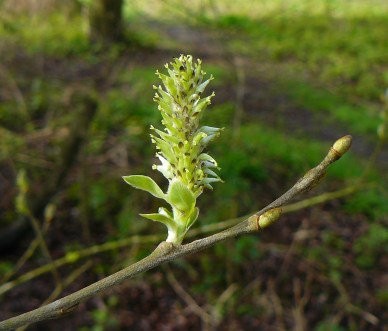
Fresh leaf buds are
present on the new Oaks on the Seagull Lane
patch, including the one I planted which has retained
its leaves over the winter. The retention of leaves
over winter by broadleaved trees is called
marcescence. Botanists are unsure why some trees
develop this habit though it does not appear to do
them any harm.
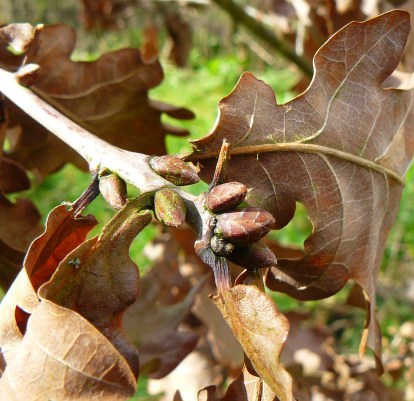
Snipe
Peter
Milinets-Raby is back from a family holiday in Naples.
After wall to wall blue skies and 16C in Naples, he
came back to hail stones, chilly blustery wind and
only 8C for his walk around Warblington this morning.
I had alerted Peter to
the sighting of two possible Jack Snipe in the
southern part of the Ibis field (east of the cemetery
extension) by Kate L'Amie while he was away. So, this
morning Peter had a look and found one Snipe hiding in
the gully along the muddy edge and 'bobbing up and
down in a very Jack Snipe-like manner when it broke
cover and was surrounded by grass'. Peter says, Snipe
is a good record for the area, but a Jack Snipe would
be a mega. March and April are peak months for Jack
Snipe, so keep looking out and remember Snipe has a
golden central crown stripe, whereas Jack Snipe has a
dark central crown stripe with thin golden stripes
either side.
On the left are
Snipe taken a few years ago at Titchfield Haven byTony
Wootton
On the right is a close-up of a Jack Snipe head
showing its distinctive pattern.
Other
birds at Warblington
Peter
Milinets-Raby's other main observations were as
follows:
Ibis Field
(from 9:05am to 9:36am) - Wow, loads of birds -
worth checking. 1 Green Sandpiper, 2 female Teal -
looking more Snipe-like than the Snipe, especially as
they were submerged in the grass with barely the
mantle showing - care needed for these two!
5 Moorhen. And the bird of the morning, a splendid
Water Pipit, which showed well for ten minutes
before a Buzzard flew over and flushed it and it
headed west. Also Skylark singing over the huge field
to the east and 4 Mediterranean Gulls over calling
Langstone Mill Pond (9:41am to 10:14am - low tide).
Off shore: 15 Red Breasted Merganser, 26 Shelduck, 162
Brent Geese, 7 Black-tailed Godwit, Male and female
Goldeneye, 4 Grey Plover, 165 Dunlin, 2 Mediterranean
Gull, 10 Teal, 13 Wigeon.
Langstone Mill
Pond: No Mallard, as the Mute Swan pair are in
residence. The female was building a nest to the rear
of the reed bed by the main viewing path/area of the
pond (back of Mill - different from last year). All
the Grey Herons were sitting tightly and it was
impossible to say which nests were occupied. I could
see three, but certainly more!
Flooded horse
paddock: 89 Teal, 1 Grey Wagtail, 26 Wigeon, 7
Black-tailed Godwit - getting regular now! 6 Moorhen,
1 Mistle Thrush, 1 Curlew, 1 female pond Pintail.
Wild
Daffodils
Roy Ewing had
a walk through Inholmes Wood near Stoughton yesterday
where the wild Daffodils are quite advanced in the
usual two locations.
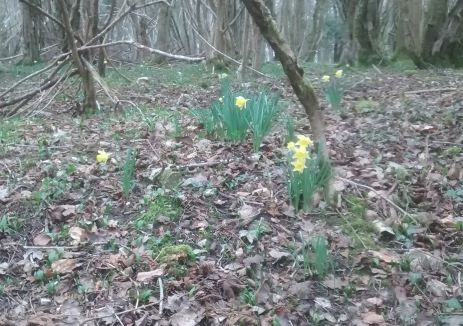
Colin's
gallery
Colin Vanner
sent me a selection of his recent excellent wildlife
photos from the Farlington/Havant area. He said the
Short-eared Owls are still at Farlington Marshes. The
Kingfisher was at Bedhampton.
The Harbour Seals were
in Langstone Harbour seen from Farlington Marshes, 11
in all but not all in the shot.
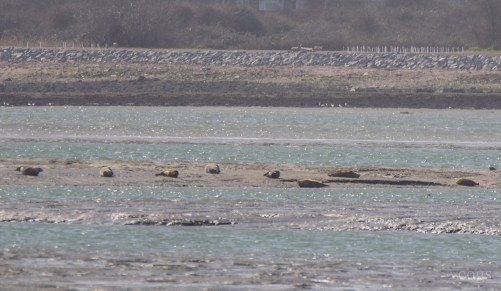
Wildlife
of India
Tony Wootton
has assembled a gallery of wildlife photos from his
recent trip to India. Click on the link below and
click on an individual photo to enlarge it. Then click
on the little ladder (bottom right) and the photo info
tab (top right) to get the name of the species. If
there is no name it's because Tony is unsure of it.
Tony saw 230 bird species and managed to photo a high
number of them with varying degrees of quality.
For bird photos go to
. . . https://adobe.ly/2ltjGQy
For non-bird wildlife photos go to . . .
https://adobe.ly/2l06IcL
SATURDAY
MARCH 4 - 2017
Stansted
Forest
Heather Mills
reported on the Havant Wildlife Group walk
Four
met on a glorious spring morning filled with an
assortment of Stansted's birds singing. Robins were
the most prolific. Nuthatch, Goldcrest, Chaffinch and
most noticeably at least 3 Song Thrush in the vicinity
of the car park. As we slowly progressed along the
main thoroughfare towards the house we could hear
Great Spotted Woodpecker drumming. The Jackdaws were
vocal and a Stock dove called.
The grounds were busy with joggers and cyclists, so we
took a muddy footpath beside the main road. Here we
saw our first Redwing and had a very close encounter
with Dunnocks foraging under our feet as we progressed
eastward. In the gardens of Stansted were masses of
Primroses. The Highland cattle had 2 young calves.
Behind the first cottages we heard our first
Yellowhammers. I counted at least 4 along this stretch
starting their song, with one nearly completing the
"little bit of bread and no cheese". Here we had good
views of 4 Meadow Pipits and a singing Linnet. Dog's
Mercury was abundant but Celandine only seen at the
entrance to the gatehouse, where Snowdrops and a small
patch of Violets were evident. A small patch of Wood
Spurge seen. As we walked towards Walderton we kept a
lookout for the Green Hellebores which were in flower.
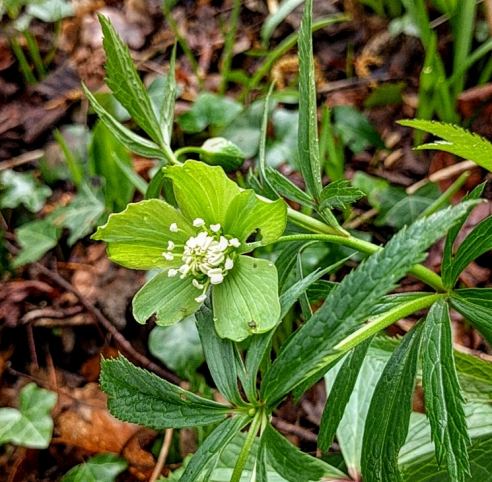
Although
several Bullfinch called along the way, we did not
locate them. A small party of Long-tailed Tits pecked
for insects as we turned north alongside the fields to
take the footpath back to the road. We came across 2
Marsh Tits along the hedgerow, whilst Coal Tit sang
and we caught a snippet of Skylarks singing, but not
for long. Beyond the 2 cottages in the past we have
been fortunate to see Fieldfare and Redwing. Today
only Redwing visible with about 20 foraging on the
ground around the trees. 31 bird species seen. A very
pleasant outing.
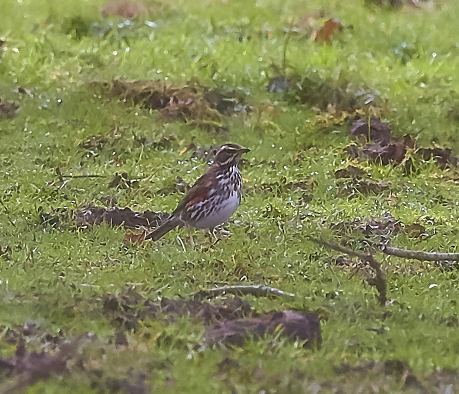
For more reports of
walks go to . . . Havant
Wildlife Group
Crane
sighting
Ralph Hollins
gives extra information about the Crane reported in
yesterday's blog.
For info on the association of the Somerset and
Slimbridge sites see first http://www.wwt.org.uk/cranes/see-cranes-at-wwt-centres/
then read about the Crane Introduction programme at .
. . http://www.thegreatcraneproject.org.uk/
and for the 'pre-history' of this project see the
following (written in 2009) see .. http://www.birdguides.com/webzine/article.asp?a=1691
about a group of Cranes which introduced themselves to
Norfolk in the late 1970s and were probably breeding
there in 1981. Ralph thinks that independent group is
still present in East Anglia and/or further north in
England
First
Comma
Ralph Hollins
says that Tony Wootton's Comma is the first he's heard
of but on checking the ButterflyConservation page at .
. . http://butterfly-conservation.org/52/first-sightings-2014.html
there is an isolated report of one in Lancashire on 20
Jan this year. But Ralph suspects that it was an
insect disturbed from hibernation rather than
naturally emerging in response to the current longer
days and high temperatures of spring. So well done,
Tony.
FRIDAY
MARCH 3 - 2017
Swans
nest building
The Mute Swan
pair were having another go at building their nest in
the corner of Emsworth Millpond near the bridge when I
passed by at about 11.30 this morning. The water in
the pond was quite high, but the nest structure had
been built quite substantially so that it was mostly
above the water level. These birds are clearly
determined!
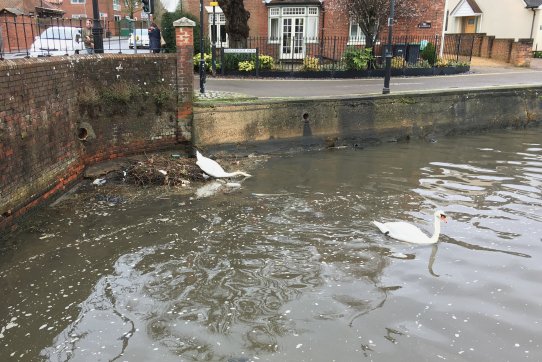
Here they are sailing
off after their spell of nest building, rulers of all
they survey! No other swan would dare trespass on
their territory.
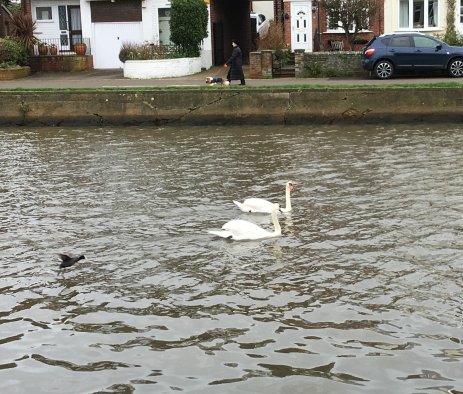
Brents
on the move
About 200
Brent Geese were on the water in the harbour in small
groups close to the millpond seawall. They are
probably preparing to fly north towards their breeding
grounds. I think they stop off in Holland before
heading north over the Baltic Sea and along the Arctic
coastline. Their destination for nesting is the Tamyr
Peninsula in Northern Siberia. A long journey, but
well honed through eons of evolution.
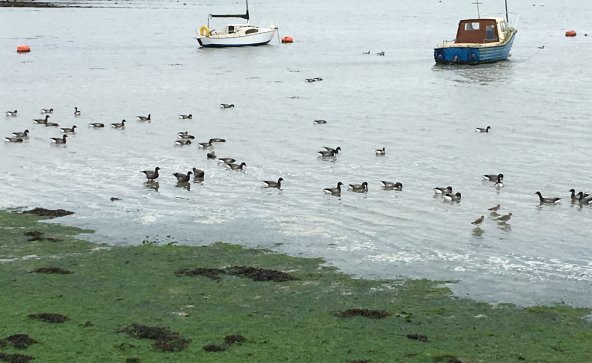
Stock
Dove in garden
After several
years of absence, Stock Doves are becoming fairly
regular visitors to our garden in central Emsworth,
though only in ones and twos. One was present again
this morning feeding alone on the grass lawn. Such a
neat, attractive and gentle-looking bird. I love the
patch of emerald gloss on its neck.
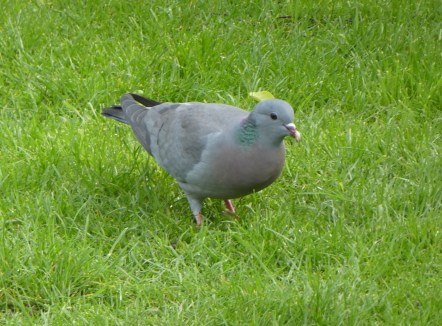
Hayling
Oysterbeds
Christopher
Evans had a walk around the oysterbeds this afternoon
and got a lovely photo of a Long Tailed Tit shortly
after leaving the small car park at the top of the
island.
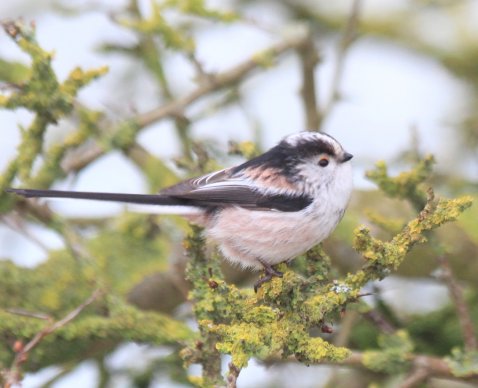
Heading down past the
beds Christopher saw 3 or 4 flocks of Dunlin swirling
around but the all eventually landed on the banks and
spits that remained above water. On the southern most
lagoon there were 5 Red Breasted Mergansers (2m, 3f)
and 5 Little Grebes in the water, with plenty of noisy
Black Headed and Mediterranean Gulls on the ridges in
the lagoon. Walking back, there was a single Great
Crested Grebe in the harbour.
Chichester
Gravel Pits
Yesterday
Christopher had his monthly U3A Birdwatching walk (and
drive around) which included Church Norton, RSPB
Pagham and finally Chichester Gravel Pits where they
managed to find the male Scaup and male Long Tailed
Duck on Ivy Lake. The former was a bit trickier to
spot as it was in with a number of Tufted Duck.
Highlights back at Pagham include a Green Sandpiper
and 3 Red Legged Partridge at the back of the Ferry
Pool, then walking down alongside the Ferry Channel, a
Reed Bunting, a Cetti's Warbler (heard not seen), a
Buzzard on a post and a flock of about 40 Avocet that
twice briefly rose in to the air before dropping down
out of sight.
Ringed
Crane
Derek Mills
sent me the following photo of a Common Crane that he
took at Titchfield Haven on Thursday 2 March. Derek
drew my attention to the rings on the bird's leg and
wondered where it came from. The rings one can see in
the photo are blue, white and yellow, though I am not
sure if this would be enough to establish the bird's
identity. There is also a black ring at the bottom of
the leg.
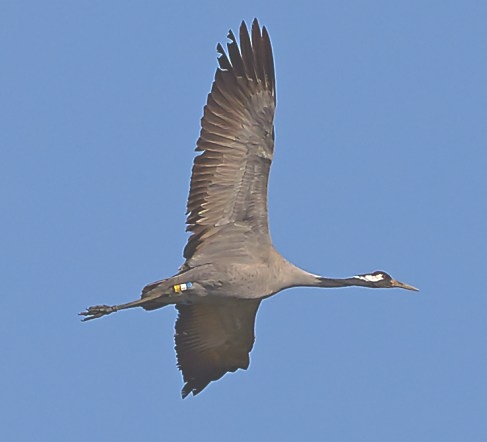
This Crane was
reported by four other birdwatchers on the HOS
sightings site goingbirding.co.uk at Titchfield Haven.
One of the observers said the Crane is a released bird
from Slimbridge with a transmitter. Another observer
said it is female ringed in Somerset in 2013. Maybe
the warden at Titchfield Haven could provide more
information? Colour-ringed birds can be reported to
European Colour-ring Birding at www.cr-birding.org
Cranes breed in bogs
and marches across north and central Eurasia and
winter in Southern Europe and Africa. They are
vagrants to the UK and very rare residents - only in
Norfolk?
Comma
Tony Wootton
had the first Comma of the year (as far as I am aware)
yesterday at Blashford Lakes. And nice one too.
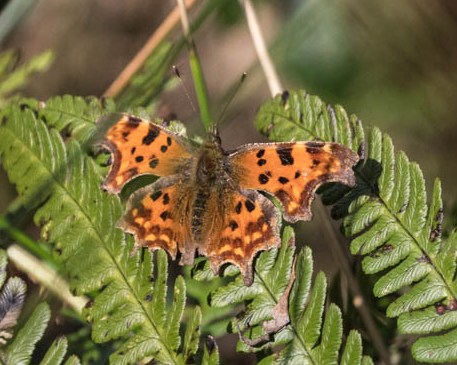
THURSDAY
MARCH 2 - 2017
Early
Meadow-grass
John Norton
was in Bedhampton yesterday and noticed a fine patch
of Early Meadow-grass (Poa infirma). It was along
Lower Road, but John thinks it might be fairly
frequent all over the general Havant area. It likes
warm, south-facing road verges and (as shown on the
photo) often forms a striking pale band of thin shoots
along the edge of the pavement or roadway.
When growing well, as
here, Early Meadow-grass looks quite different from
Annual Meadow-grass. It is yellowish-green in colour
whereas Annual Meadow-grass tends to be bright or dark
green. The following close up photo of Early
Meadow-grass (on the left in the photos below) is one
of John's stock photos taken in Gosport in 2008. The
panicle tends to be less open than that of Annual
Meadow-grass (shown on the right taken on Brook
Meadow).
Early Meadow-grass was
formerly only in Cornwall and Hayling Island, but has
spread rapidly in recent years. We would be interested
to hear from anyone who has seen any.
Unusual
moss
John also had
an unexpected find of a nice little moss called
Scorpiurium circinatum, growing on a
railway bridge (private land). It is a warmth-loving
limestone species, common in places like Portland,
Dorset and parts of the Isle of Wight, but rare in
Hampshire, where hitherto only found on old abbeys and
similar buildings. John also discovered some at Hurst
Castle last year. The nearest other site to us is
Portchester Castle, where John has looked for it, but
couldn't refind it. It has distinctive curved
mouse-tail like shoots which hang downwards. The ruler
shot shows the more distinctive dry leaves and the
other shows slightly moistened leaves which have
started to swell up and stick out. The shoots are
quite small, but it often forms large
patches.
Wayside
flowers
I had a stroll
around my local area this afternoon looking closely at
roadside verges for any sign of Early Meadow-grass. I
did not find any, but I was pleased to locate several
other interesting flowering plants. They included a
splendid display of Sweet Violets along Warblington
Road and Valetta Park, plus nice patches of Common
Field Speedwell, Common Chickweed and Lesser
Celandines.
More
on Nightingales
Tom Bickerton
added the following comments to the discussion in
yesterday's blog about Nightingales at Marlpit Lane:
"One
thing you should highlight is the RSPB are fighting a
development at Lodge Hill, Kent of 5000 houses which
they feel will impact on the Nightingales there.
That's great, but, we have a proposed 6000 development
here at Whitely, close to Botley Wood where these
birds are. Now the argument is there's enough distance
between the two locations, I disagree as it's the
impact of the increased number of people using the
Wood for leisure, walking etc.
It's not only Nightingales which are in danger, but
the small numbers of Nightjar which attempt to breed
there. The nightingale population has declined in the
UK by 90% since 1967. Human progress will ultimately
be responsible of the extinction of summering migrants
in Southern England."
Just for interest, I
did a bit of research on the global status of the
Nightingale which does not appear to be anywhere as
critical as it is in the UK. Nightingales have an
enormous global range covering most of Asia, Europe
and Africa (except the far south). Their global
population is said to be in the range 43 million to 89
million, including an estimated 8 million to 23
million in Europe alone. Birdlife.org reports that
globally the Nightingale population trend appears to
be stable and is not believed to approach the
thresholds for the population decline criterion of the
IUCN Red List (i.e. declining more than 30% in ten
years or three generations). For these reasons, the
species is evaluated by Birdlife as of 'Least
Concern'.
For more information see . . . . http://www.avibirds.com/html/Nightingale.html
Jack
Snipe?
Kate L'Amie is
90% certain that she saw two Jack Snipe a couple of
times recently close to where the Solent Way path from
Warblington to Emsworth passes over a small stream
before the large arable field at Grid Ref: SU 731054.
Kate says they were in the field to the north of the
path, south of the large muddy section. I would
appreciate any confirmation of this very interesting
observation. The Hampshire Bird Report describes Jack
Snipe as 'A scarce but overlooked winter visitor and
passage migrant'.
WEDNESDAY
MARCH 1 - 2017
Millpond
Swan nest
Anne Moodie
solved the mystery of the new 'nest' near the bridge
on the millpond that I noted in yesterday's blog. Anne
and her husband saw the two resident Mute Swans
actively building the nest last Saturday. Here is
Anne's photo of the pair at work.
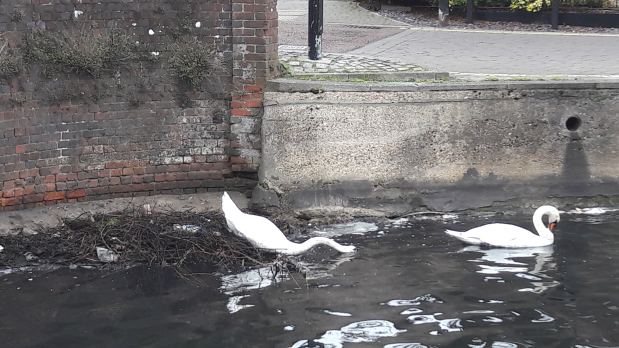
This is interesting as
they did not attempt to build a nest on the millpond
last year which was their first year of residence on
the millpond. These were the swans that aggressively
ejected the previous pair which had successfully
nested for the previous three years. As this is most
likely to be their first nest it will almost certainly
be a bit rough and ready. Swans usually take a few
years to get their nest building skills properly
honed. But we shall see.
I had a walk round the millpond at about 11am this
morning and there had been no further progress on the
nest, which had been largely swamped by the high tide.
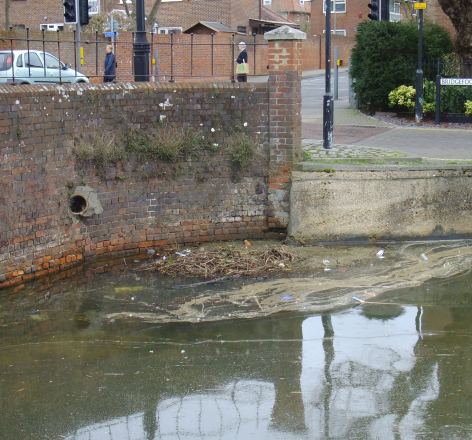
Hige tides will be a
constant hazard for the swans unless someone persuades
the Environment Agency to control the level of water
in the millpond - which they have done in the past for
the previous pair of swans. I found the pair of swans
patrolling the wall by the sailing club to make sure
no intruders get onto the pond. They are serious!
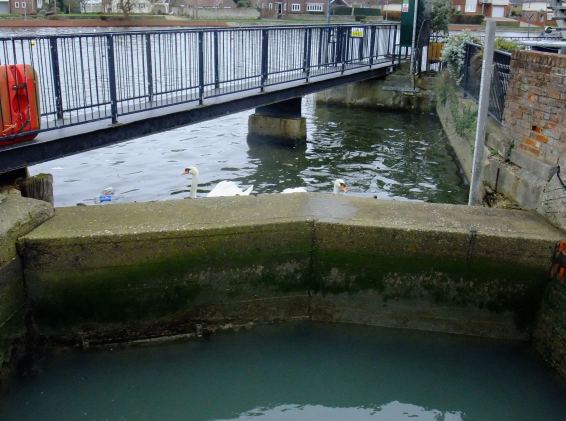
The 6 Black Swans were
on the shore at the bottom of South Street as usual,
being fed by families.
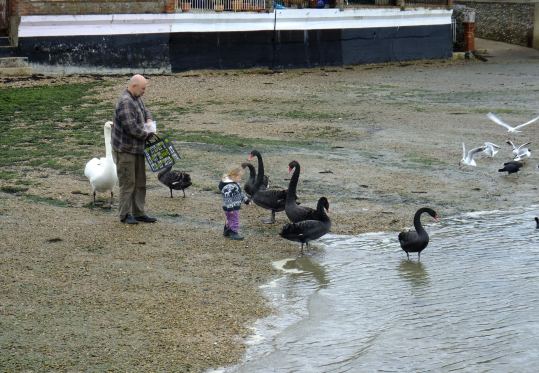
Nightingales
at Marlpit Lane
In this blog
for Feb 17 I included report from Roy Ewing concerning
construction work on the site to the east of Marlpit
Lane which might well impact on the breeding of
Nightingales in that area. Well, Tom Bickerton has
written to reassure everyone, he says, about what
exactly is going on at this site.
"I've
known the landowner and that patch for 30 years, he is
one of the good guys and during the time I've known
him I've made him aware of these birds. The land is
going back to a hay meadow, some trees will have to
go, areas of low-shrub will stay. He is getting advice
from West Sussex conservation.
Now the bad news. I don't think these birds are
sustainable, not because of alteration, but year on
year they have declined, they have been in isolation
all these years, the surrounding habitat doesn't suit
their needs for expansion. We need two adults plus 1
young to survive to maintain a breeding population, we
simply are not getting that. Whether the problems here
or in the African wintering grounds who knows, I
suspect both.
Now some good news, Nightingales are about here
locally in Hampshire, certainly around Havant Thicket
and the Rowlands Castle to Finchdean strip, not huge
numbers, you just have to listen."
I welcome any comments
on Tom's report. All I can say, having watched and
listened for Nightingales along Marlpit Lane for the
last 30 years or so, and having done several surveys
during that time, is that Tom is correct that
Nightingales have become more scarce at that site,
though there has been a tendency over the years for
them to move northwards up the lane. But, from what I
understand from BTO research, the decline in
Nightingales is not restricted to Marlpit Lane, the
tend is more general. It appears that the migrant
Nightingale population is gradually shifting eastwards
with the result that they are on the increase in
eastern counties such as Kent and Essex, but declining
in Hampshire and Sussex.
Mediterranean
Gulls
Regarding the
Mediterranean Gulls at Hayling Oysterbeds, Tom
Bickerton says 159 were counted on the recent low tide
count at the Oysterbeds, along with over 1200
Black-headed Gulls. A raft is being built which will
be anchored off South Island at the Oysterbeds for the
terns. They might be lucky to get a few Med Gulls
nesting at the Oysterbeds. Hopefully the raft will
prove as successful as the Blashford Lake. What is
needed is a replica of the one at RSPB Ham
Wall.
TUESDAY
FEBRUARY 28 - 2017
Emsworth
Millpond
It was a very
pleasant morning for a stroll around the town millpond
despite the chilly breeze. The first thing I noticed
was a large pile of twigs and other debris in the
north-east corner close to the road bridge. A new
swan nest? Mute Swans have nested at this spot in
previous years, so it could represent the first
efforts at nest building by the new pair of swans
which have dominated the pond over the past 2 years,
driving off all other swans that dare trespass on
their territory. It is a very crude effort with
several items of litter mixed in. There was no sign of
any swans in the vicinity. In fact, I could only find
one swan on the millpond this morning. Where has the
other one has got to? Of course, the nest of twigs may
have been placed there by human hand to provide
building materials for the swans. I would appreciate
any information on this. In the meantime, watch this
space, so they say.
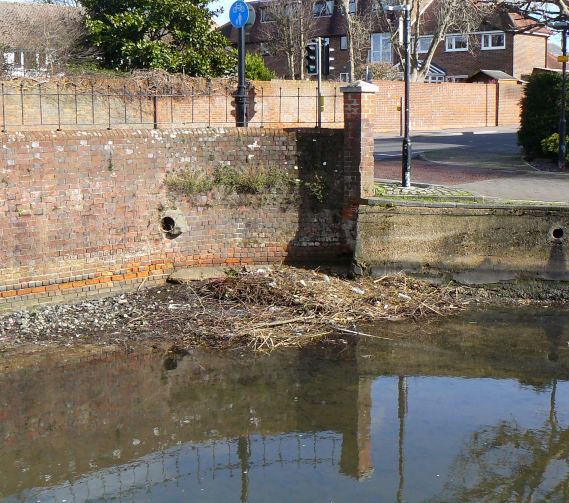
Emsworth
Harbour
A flock of
about a dozen Swans were gathered in the harbour by
the quay, including the six Black Swans which
have been here for the past 4 weeks. The Black Swans
can be a bit feisty towards their white colleagues.
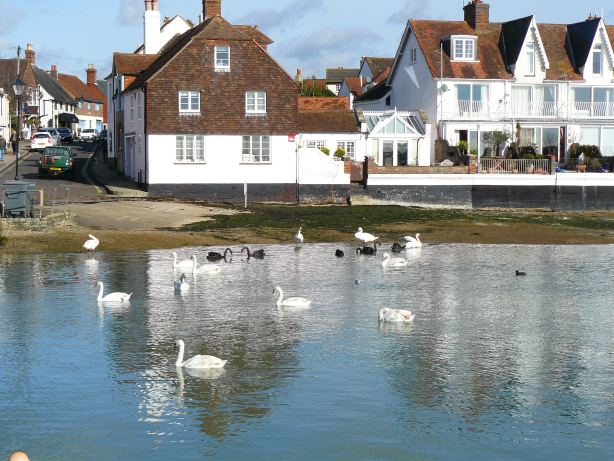
A few Brent
Geese were on the water close to the millpond
seawall. I suspect many of their colleagues will have
already left and be on their way towards their
breeding grounds in the Russian Arctic. Fare forward
travellers.
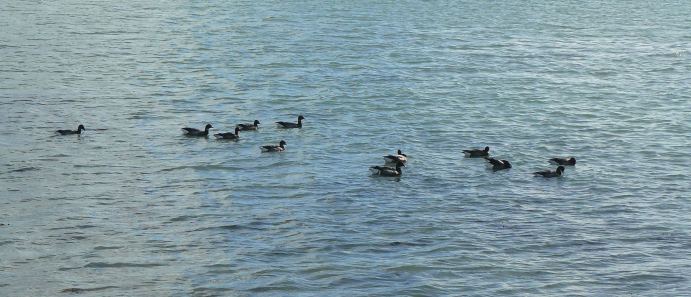
Hayling
Oysterbeds
My friend John
Gowen was at the Hayling Oysterbeds this morning and
was surprised by the number of Brent Geese he saw
there, mostly in groups of 40. He asks if they should
have moved out. The answer to this is yes. The Brents
are certainly on the move, but the birds John is now
seeing are most likely to be those passing through,
having wintered further to the south, on their way to
Holland and up to the Arctic
John asked if I knew about the Brent breeding
success this year. I don't think the official
figures are available yet, but my own counts indicate
a relatively poor year with about 4% of juveniles to
adults.
John also noticed hundreds of Black-headed
Gulls on the shingle bars in the main/southern
most pool of the Oysterbeds. These birds will be
gathering together in preparation for the coming
breeding season, bagging themselves the best nesting
spots no doubt. I hope they leave some space for the
Common Terns and Little Terns. Mediterranean Gulls
also nest at Hayling Oysterbeds, though I think most
now go over to the RSPB islands in Langstone Harbour.
Brook
Meadow
From the
harbour I made my way home via Brook Meadow where I
heard a Blackbird in full song in the middle of the
day for the first time this year. All the other
Blackbird songs have been heard at dusk.
I was interested to
see a raised Mole run across the path through
Palmer's Road Copse. These are caused by the mole
tunnelling close to the surface, producing a raised
line of soil.
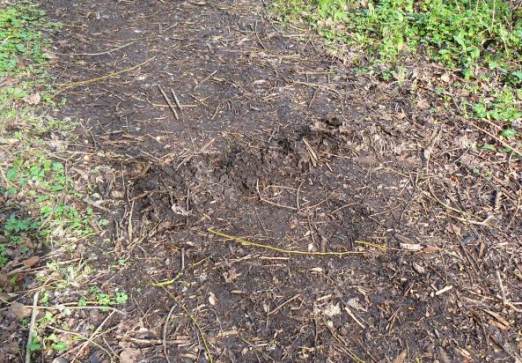
The Weeping
Willow at the north end of the south meadow is
looking quite splendid. This handsome tree was planted
around 2001 as a young sapling by Brian Boak. Brian
was an active member of the Brook Meadow Conservation
Group in the early years, though I think he has now
passed away.
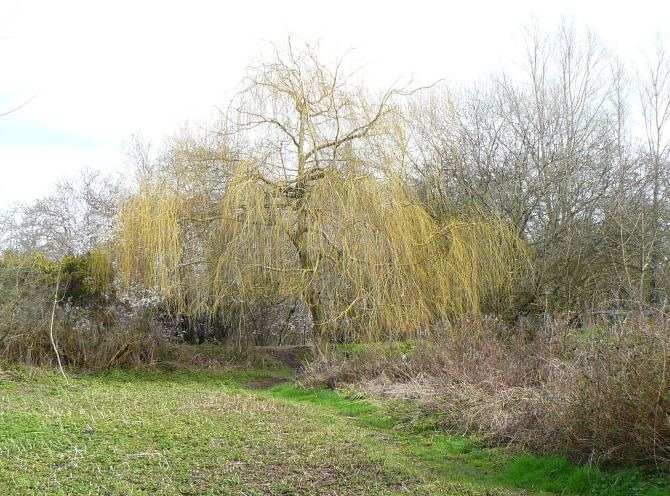
The yellowish glow of
the tree is caused by the colour of its twigs which
are already sprouting fresh leaves.
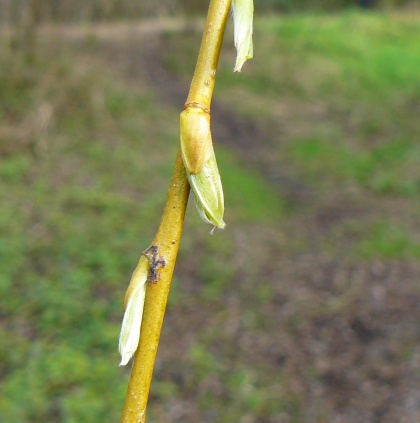
The Butterbur
flower spikes on the meadow above the seat are now
clearly visible from the main path. Some are quite
well grown.
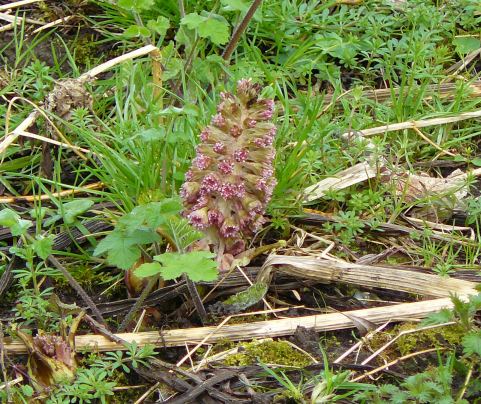
A large Crack
Willow on the west side of the river north of the
Bulrushes has collapsed across the river. The branches
have been cut back where it came across the footpath.
It does not seem to be blocking the river.
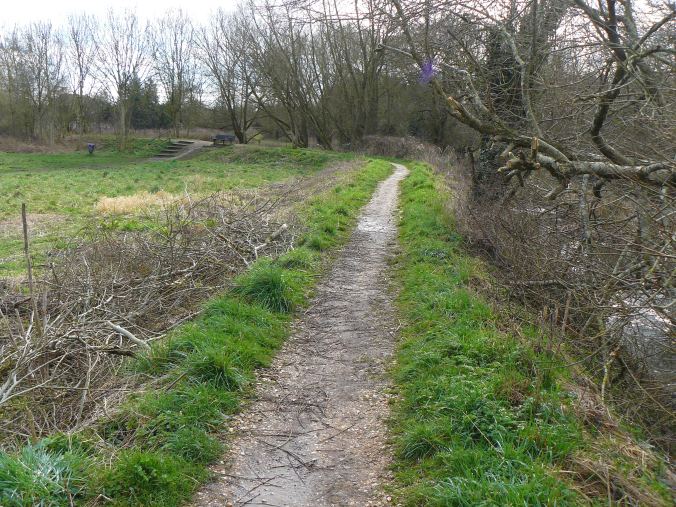
A pair of
Mallard were swimming around on the river south of
the north bridge. They may nest somewhere on the west
bank.
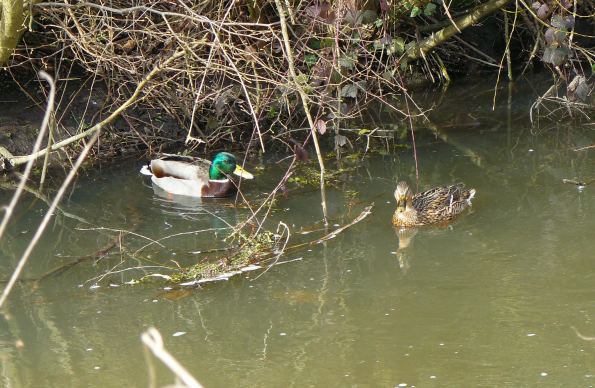
SUNDAY
FEBRUARY 26 - 2017
Emsworth
walk
I had my usual
walk this morning through Brook Meadow and down to
Slipper Millpond. The weather was cloudy, but
otherwise fine. The paths on the meadow are drying out
nicely and boots are not needed. Here are a few
observations with photos.
Brook
Meadow
I looked
closely at the various leaves that are now coming up,
including Broad-leaved Dock, Bristly Ox-tongue (left
in photo) and Spear Thistle (right).
I gather the red spots
and blotches on the dock leaves are caused by a
fungus.
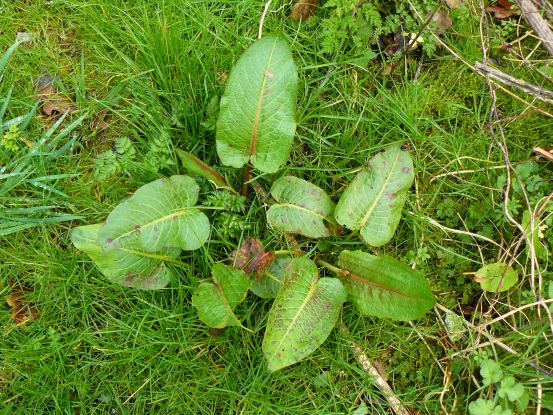
There is a fine
blossom on the Cherry Plum on the causeway almost
forming an archway with the yellow Gorse.
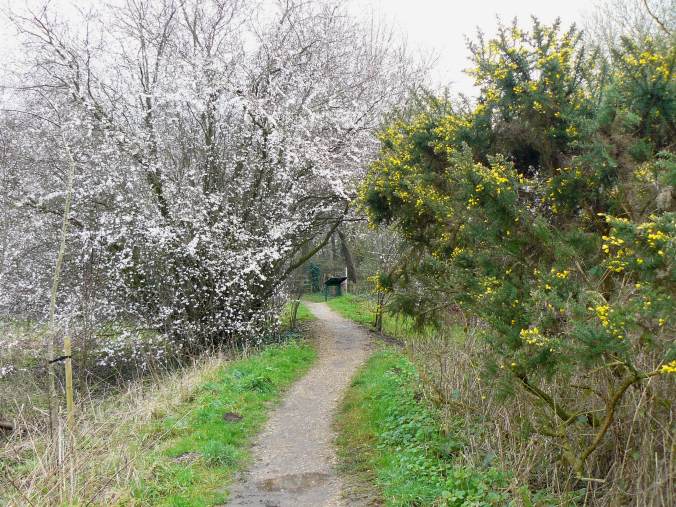
The long brown catkins
on the Alders are now ripe and looking very good,
hanging like decorations.
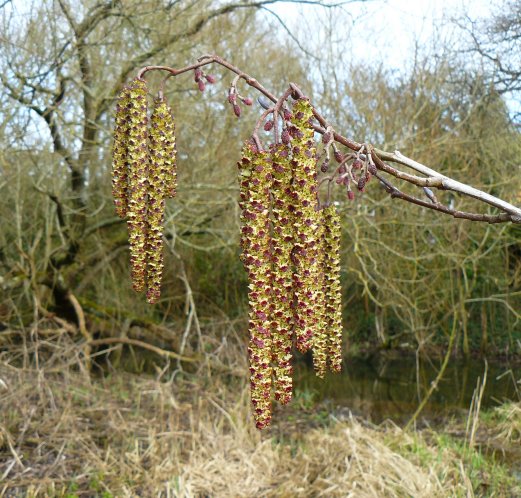
The small bright red
female Alder catkins which will develop into cones are
also prominent.
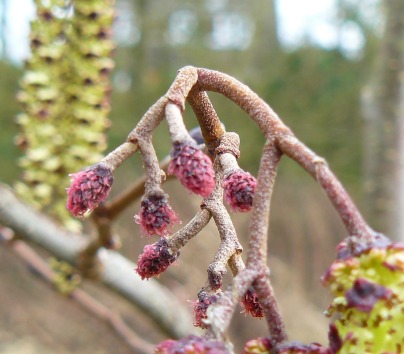
On the east side of
the north meadow, the Osier male catkins are already
showing some yellow pollen.
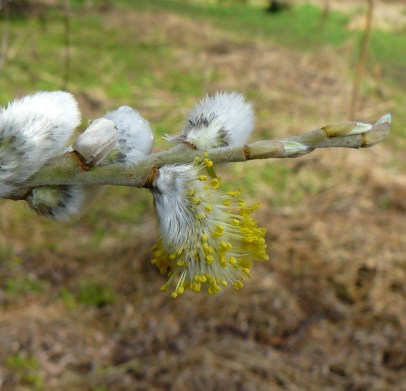
Several quite well
grown Butterbur spikes are now up in the area below
the seat.
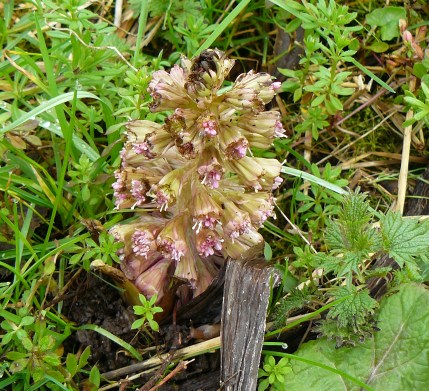
Lesser Celandines are
now popping up around the meadow, a real sign of
spring.
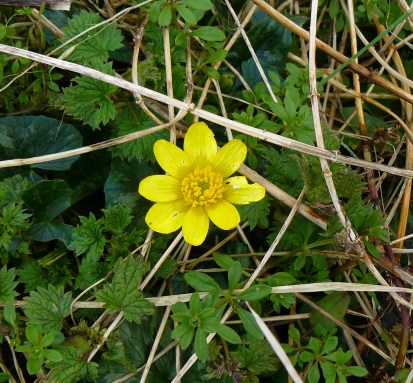
Snowdrops are
flowering along the Lumley Path, probably garden
escapes.
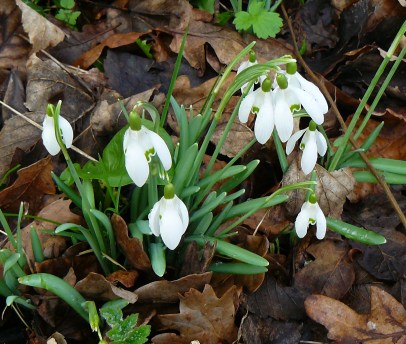
Hermitage
Millponds
David Gattrell
was at work in the reedbeds on Peter Pond so I did not
disturb him, though I did admire the new channel which
showed up well at high tide. The haze in the photo is
smoke from a fire.
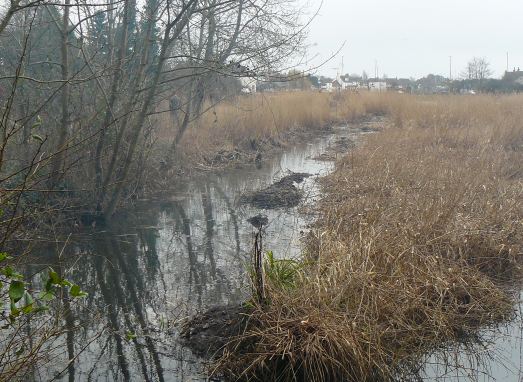
Two Mediterranean
Gulls were on Slipper Millpond along with a multitude
of other gulls. They will be off to the breeding
colonies in Langstone Harbour. I managed to get a shot
of one of them.
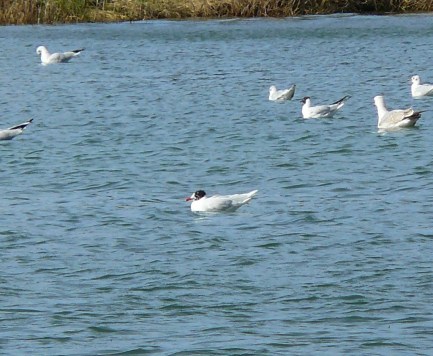
The Great Black-backed
Gull pair was on the south raft along with a grey
headed Cormorant with white breeding thigh patch. The
gulls will not be nesting on this raft, but on the
large centre one.
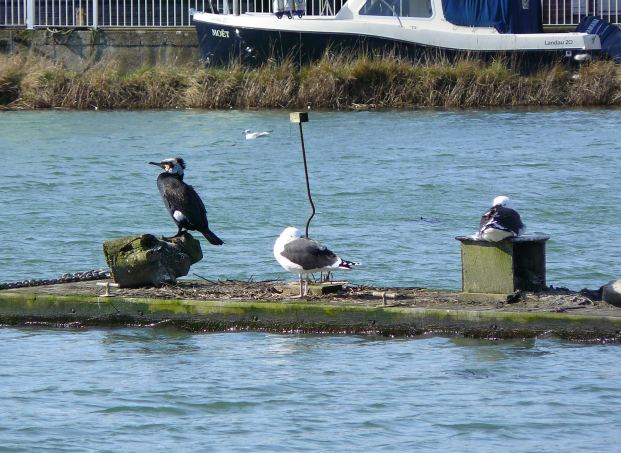
For
earlier observations go to . . February
1-28